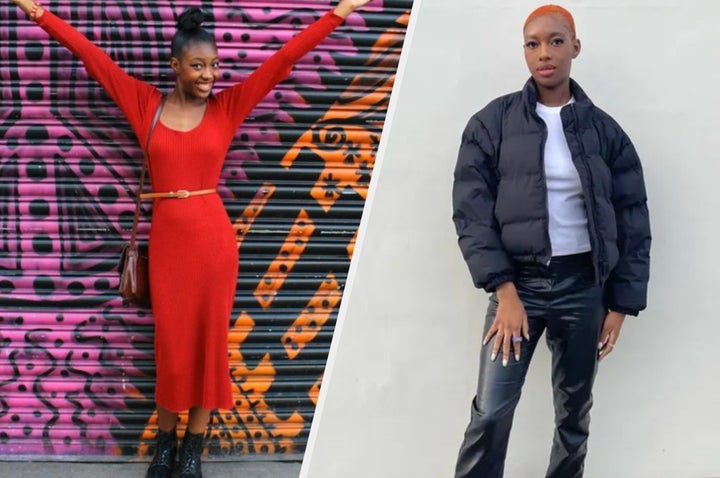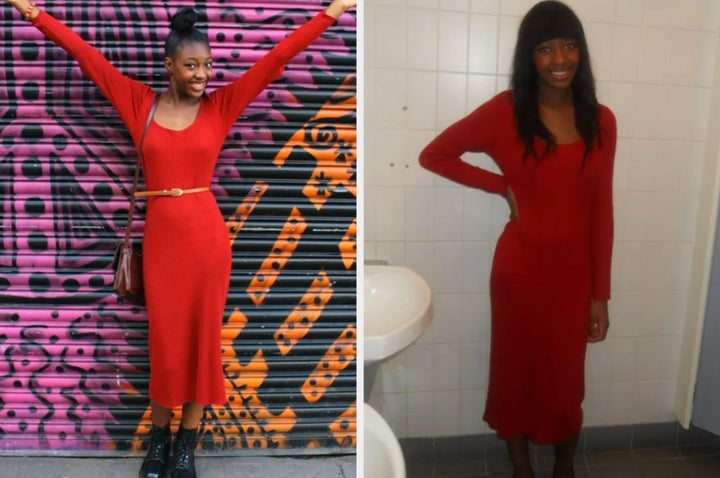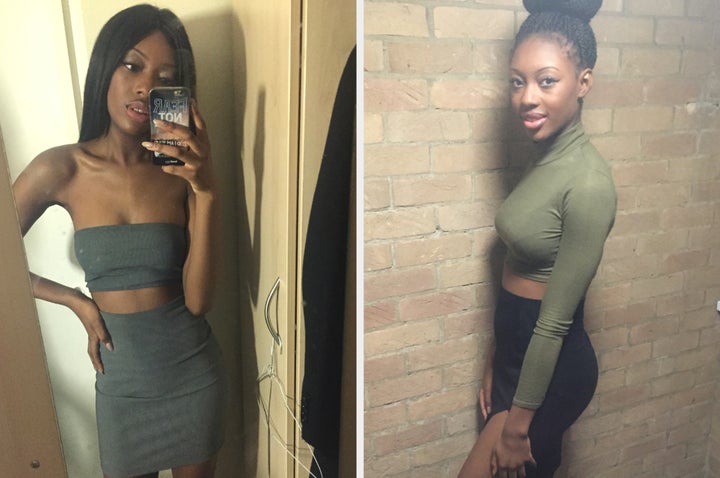
Like many of us who live on the cusp of two generations – millennial and Gen Z – I have a complicated relationship with fashion. I grew up, for the most part, without social media and the pressures of having to look perfect all the time. Prior to the days of Instagram, I was the queen of rewearing clothes, to the point where my mum actually referred to some of my outfits as “uniforms”.
In secondary school I was a big fan of thrifting and going to charity shops. It felt exhilarating finding clothes that weren’t on the high street so I could cultivate my own sense of style. My look was pretty vintage-inspired – centring around a classic pair of Levi’s that stuck with me for years. There were also lots of knit jumpers, silk skirts and graphic tees.
The high street wasn’t totally off limits – my number one item of this period was an orange ribbed dress from Primark. I wore this dress to the point of no return. It fit me like a glove and I managed to style it differently every time I wore it.
Then I went to university and fell down a whole new fashion hole. It was 2014, when Instagram and influencers were on the come-up. I’d joined the platform in 2012 when I was just about to start sixth form, way before the days of fashion drops and influencer collaboration deals. But time – and fashion – moves quickly. By uni, most of my style choices were guided by what I saw online.
Back then, sustainability wasn’t as foregrounded as it is today. And as a university student with limited income, fast fashion became my best friend.

As the resident ‘out-out’ girl, I was mostly buying dresses, heels and party tops. I was a regular on sites like Pretty Little Thing and Missguided, and the high turnover proved perfect, because I didn’t want to be seen in the same outfit twice. It also helped that the clothes were so cheap. I bought new and often.
It was thrilling, addictive even, but there was a downside: I began losing my personal style. In fact, choosing outfits started giving me real anxiety – I found myself wanting to look like the girls on the gram and to wear what they wore.
And it wasn’t a phase – after uni I remained in bondage with fast fashion. I was growing a small following online and wanted to keep up appearances with my peers. At the same time, I was on an intern’s salary so money was limited.
It was 2020 when I first picked up Lauren Bravo’s book, How To Break Up With Fast Fashion. In it, Bravo looks at how fast fashion has made us shop impulsively, encouraging us to amass heaps of clothes we never actually wear – and the damage this is doing to the environment. She is after solutions, too, and so speaks to a range of fashion voices about how we might shop differently.
“Go back to your own wardrobe and think, ‘Have I got something like this already? Do I need it? Is it going to make me happier? What can I style it with? Can I wear it with five other things that are in my wardrobe?’” Sophia Slater, sustainability and fashion ethics expert, advises Bravo in the book.
Once I’d read these words, I looked at my own wardrobe in a different way. Firstly, I realised my anxiety around choosing outfits wasn’t about not having enough clothes in my closet – it was down to me losing that sense of personal style. I couldn’t work out what I, Habiba, wanted to wear because I was too consumed with what everyone else was wearing.
Secondly, I saw that my outfits were all over the place. I didn’t really own any wardrobe staples (white tops, jeans, blazers). Instead I fed into micro-trends – meaning I bought clothes that were only “in” for short periods of time.

Take the House Of Sunny Hockney Dress. For a hot minute, this style was everywhere, with fast fashion brands feverishly copying the brand’s design. Then, after a few months, people stopped wearing them. I’ll admit to buying a dress similar to that original one. I haven’t worn it since last summer.
It was 2021 when I decided to start being more intentional with my shopping and try following the near-mythical advice of a hundred fashion editors and sustainability experts: to build a capsule wardrobe. Though I knew this approach to my clothes would be better for the planet, if I’m being honest, my reasonings were more about me than the environment.
I was excited to see if – and how – I could rediscover my own sense of style. I wanted to be able to look in the closet and not feel impending doom about my outfit choices. And doing a huge clear out felt like a relief. It was great to get rid of so many clothes I wasn’t wearing. It was also shocking how many items I owned. I told myself: focus on buying the clothes you need, rather than want.
“The most important thing is that it fits you, your personal needs and your individual everyday life.”
- Lena Krau and Lisa Wohlfarth on a capsule wardrobe
So what did I need? According to Lena Kraus and Lisa Wohlfarth from Everless Wardrobe and Vinted the right capsule wardrobe contains fewer garments, but should actually offer you more choice. “It is colour-coordinated, timeless and offers as many possible combinations as possible. And the most important thing is that it fits you, your personal needs and your individual everyday life,” they told me.
This sounded positive – and Kraus and Wohlfarth also emphasise how much time, energy, money you save, all while reducing your ecological footprint.
I went to Tik Tok to find inspiration on how to build my capsule. The people I followed advised buying staple pieces such as plain tops, jeans, trousers, blazers and bodysuits. Essentially, things you can wear every day and style up or down with different clothing and accessories, depending on the occasion.
Starting out with this new approach to fashion has been both overwhelming and underwhelming at the same time.
Cost wise, I’ve tried to buy staples I know will last but are still affordable – so I’ve shopped at places like H&M, Zara and ASOS. Additionally, I’ve also bought from smaller more sustainable brands like Sio Studios. While on the pricier side, Sio’s mesh top and skirt have already had plenty of outings.
There have been high-street wins, too. I bought a particular white top from Zara a few months ago I now wear everywhere. It goes with everything, it’s cool and easy to style with a pair of jeans or a ribbed skirt (ribs – still a classic!). Even though I’ve worn it on repeat, it feels good to know I’m getting cost per wear.
It’s like Kraus and Wohlfarth say about capsule building: “The number of bad and frustrating purchases decrease, because you value your favourite pieces much more and are generally much happier with your wardrobe. You’re no longer constantly on the lookout for that new happy feeling.”
After a few months, though, I couldn’t ignore that my closet was getting blander. All I was buying were plain tops and trousers. Nothing really stood out. And when it came to planning outfits, instead of mixing and matching to find new combinations, I was reverting to wearing the same outfit again and again.
I knew buying less might mean this, but why can’t I enjoy repeating items and outfits, even if I look and feel good in them? It worked for me as a teenager.

Social media comes into play here, of course. Most of the people I follow on Instagram wouldn’t be caught dead wearing an outfit twice (at least not on their grid). And this makes me feel like I should follow suit – only not the same suit! – and keep things fresh and new.
I need to remember the goal (and reward) in all this: reclaiming my personal style. I love the fact I have a favourite top again. And I’m still allowed to love shopping. “Once you’ve established the basics in your closet, it’s now a matter of identifying missing pieces of clothing,” Krau and Wohlfarth advise me. “By writing a targeted wish list, you can achieve conscious-shopping behaviour.”
Be alive and alert to possibilities, they suggest. “Analysing is all about looking for inspiration, discovering your own style, creating your personal colour concept, and using outfit formulas to develop outfit combinations that work.”
My lack of new clothes has certainly forced me to be more creative. Now I actively go into my wardrobe to see which top goes with a specific skirt or how I can re-style the dress I wore a few weeks ago, rather than go online to buy a new one for a specific occasion.
Again and again, Instagram has made me want to quit my new path and give into impulse buying. But when I feel that instinct to spend, I try to look at all the clothes I already own and think how I can style them up. Doing this reminds me I have more than enough.
When I used to go shopping with my mum, before I bought any new item, she would ask me how I’d be able to wear it with clothes I had back home. She recognised the importance of building a wardrobe rather than an outfit. I try to ask myself the same question now before purchasing something new.
And as time goes on, I’m feeling like my old teenage self, someone who cares less about what other people think of me and more how I can express myself through my clothes. I want to build a wardrobe that’s not only timeless but represents who I am. Releasing myself from the bondages of fast fashion isn’t easy, but I hope future Habiba – and the planet – will thank me.